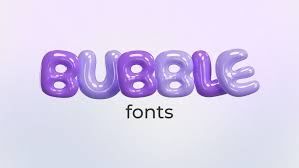bubble font Typography plays an essential role in communication, often setting the tone of the message even before words are read. Among the various typography styles, bubble fonts stand out due to their whimsical, rounded shapes that evoke a sense of fun and lightheartedness. Whether used for party invitations, branding, or children’s projects, bubble fonts have a way of capturing attention and adding a playful element to design. In this article, we’ll explore the world of bubble fonts, their uses, and how they can elevate your creative projects.
What is a Bubble Font?
A bubble font is a style of typeface that features rounded, inflated, and often exaggerated shapes, resembling the appearance of bubbles or balloons. These fonts are known for their soft, smooth curves, which give them a friendly, approachable feel. Typically, bubble fonts have thick lines, and some may even include a 3D effect that makes them appear as though they’re floating off the page.
The history of bubble fonts can be traced back to playful, informal lettering styles used in comic books, advertisements, and pop culture in the mid-20th century. Their appeal grew as they became associated with creativity and fun, often linked to children’s books, cartoons, and party invitations. The defining feature of bubble fonts is their ability to bring a cheerful, carefree vibe to any design project, making them a popular choice for more casual or creative designs.
Bubble fonts differ from other types of typography such as serif or sans-serif fonts, which are typically more formal and structured. Unlike these more traditional fonts, bubble fonts are informal and tend to break the rules of typography, making them a versatile choice for projects that need a touch of whimsy.
Popular Uses of Bubble Fonts
Bubble fonts are a favorite among designers for projects where fun and creativity are key. One of the most common uses of bubble fonts is in children’s materials. From classroom posters to birthday party invitations, the playful nature of bubble fonts appeals to young audiences, making them ideal for educational or celebratory purposes. The fonts’ bold, easy-to-read shapes also help capture attention, making them perfect for kid-centric content.
Another popular application of bubble fonts is in party decor and invitations. Whether for weddings, baby showers, or holiday parties, bubble fonts add a festive and lively touch to invitations, banners, and signs. Their vibrant, joyful appearance helps set the tone for the event, creating an inviting atmosphere.
In the world of branding, bubble fonts are often used to convey a playful and approachable image. Brands that cater to younger audiences or those looking to present a fun, informal vibe—such as toy companies, children’s clothing brands, and even some social media influencers—frequently incorporate bubble fonts into their logos or marketing materials. The visual softness of bubble fonts can make a brand feel more friendly and relatable.
Moreover, bubble fonts are widely used in social media and web design. With the rise of visual platforms like Instagram and Pinterest, bubble fonts are often employed to enhance the aesthetic appeal of posts, stories, and banners. They also make appearances in merchandise design, including t-shirts, stickers, and posters, giving products a unique and fun look.
How to Choose the Perfect Bubble Font for Your Project
Choosing the right bubble font for your project can be tricky but rewarding. The first thing to consider is the tone of your project. Bubble fonts come in a variety of styles—some more bold and loud, others more subtle and rounded. The tone of your project should match the energy of the font. For example, if you’re creating a birthday invitation for a young child, a more playful, cartoon-like bubble font would work well. On the other hand, if you’re designing a logo for a children’s boutique, you might want to choose a softer, more elegant bubble font.
Legibility is another important factor when choosing a bubble font. While the playful shapes are fun, some bubble fonts can be difficult to read, especially at smaller sizes. It’s essential to test the font across different sizes and formats to ensure it remains clear and legible. Additionally, consider pairing bubble fonts with other typography styles. A bubble font for headings, combined with a simpler sans-serif font for body text, can create a balanced design that is both eye-catching and readable.
Lastly, customization is key. Many bubble fonts allow for alterations in size, spacing, and color. By adjusting these elements, you can make the font truly your own. Customizing the font can help better fit it to your project’s needs, ensuring that it complements the overall design while maintaining its playful essence.
Free vs. Paid Bubble Fonts: Where to Find Them
One of the best things about bubble fonts is the variety of sources available for both free and paid options. Several websites offer free bubble fonts that can be easily downloaded and used for personal projects. Websites like DaFont, Google Fonts, and FontSpace offer a wide range of bubble fonts that you can incorporate into your design work without cost.
While free fonts are great for many projects, sometimes investing in a paid bubble font is worth it, especially for commercial use. Paid fonts typically come with licensing that allows for wider usage, such as in branding, merchandise, or large-scale marketing campaigns. Additionally, premium bubble fonts often come with more stylistic options, including variations in weight, style, and even 3D effects, which can add a professional edge to your designs.
When downloading fonts, be sure to check the license terms. Some free fonts are only available for personal use and require a license for commercial projects. Following these guidelines ensures you’re using the fonts legally and responsibly.
Conclusion
Bubble fonts are a fantastic way to inject fun, creativity, and personality into your design projects. Their versatility makes them suitable for a wide range of uses, from children’s materials to branding and party decor. By understanding how to choose the right bubble font, where to find them, and how to use them effectively, you can create designs that stand out and capture attention. Whether you’re a graphic designer or a business owner, bubble fonts offer endless possibilities for playful, engaging typography.



